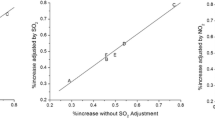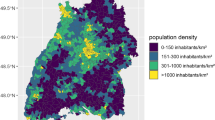Abstract
Epidemiologic studies relating ambient ozone concentrations to adverse health outcomes have typically relied on spatial averages of concentrations from nearby monitoring stations, referred to as “composite monitors.” This practice reflects the assumption that ambient ozone concentrations within an urban area are spatially homogenous. We tested the validity of this assumption by comparing ozone data measured at individual monitoring sites within selected US urban areas to their respective composite monitor time series. We first characterized the temporal correlation between the composite monitor and individual monitors in each area. Next, we analyzed the heteroskedasticity of each relationship. Finally, we compared the distribution of concentrations measured at individual monitors to the composite monitor distribution. Individual monitors showed high correlation with the composite monitor over much of the range of ambient ozone concentrations, though correlations were lower at higher concentrations. The variance between individual monitors and the composite monitor increased as a function of concentration in nearly all the urban areas. Finally, we observed statistical bias in the composite monitor concentrations at the high end of the distribution. The degree to which these results introduce uncertainty into studies that utilize composite monitors depends on the contributions of peak ozone concentrations to reported health effect associations.





Similar content being viewed by others
References
Adams WC (2002) Comparison of chamber and face-mask 6.6-hour exposures to ozone on pulmonary function and symptoms responses. Inhal Toxicol 14:745–764
Adams WC (2003) Comparison of chamber and face mask 6.6-hour exposure to 0.08 ppm ozone via squarewave and triangular profiles on pulmonary responses. Inhal Toxicol 15:265–281
Adams WC (2006) Comparison of chamber 6.6-h exposures to 0.04-0.08 ppm ozone via square-wave and triangular profiles on pulmonary responses. Inhal Toxicol 18:127–136
Breusch TS, Pagan AR (1979) A simple test for heteroskedasticity and random coefficient variation. Econometrica 47(5):1287–1294
Cleveland WS, Graedel TE (1979) Photochemical air pollution in the Northeast United States. Science 204:1273–1278
Dias D, Tchepel O (2014) Modelling of human exposure to air pollution in the urban environment: a GPS-based approach. Environ Sci Pollut Res 21(5):3558–3571
Goldman GT, Mulholland JA, Russell AG, Strickland MJ, Klein M, Waller LA, Tolbert PE (2011) Impact of exposure measurement error in air pollution epidemiology: effect of error type in time-series studies. Environ Health 10:61
Ito K, Thurston GD, Silverman RA (2007) Characterization of PM2.5, gaseous pollutants, and meteorological interactions in the context of time-series health effects models. J Expo Sci Environ Epidemiol 17:S45–S60
Kelly JT, Baker KR, Napelenok SL, Roselle SJ (2015) Examining single-source secondary impacts estimated from brute-force, decoupled direct method, and advanced plume treatment approaches. Atmos Environ 111:10–19
Kim CS, Alexis NE, Rappold AG, Kehrl H, Hazucha MJ, Lay JC, Schmitt MT, Case M, Devlin RB, Peden DB, Diaz-Sanchez D (2011) Lung function and inflammatory responses in healthy young adults exposed to 0.06 ppm ozone for 6.6 hours. Am J Respir Crit Care Med 183:1215–1221
Marshall JD, Granvold PW, Hoats AS, McKone TE, Deakin E, Nazaroff WW (2006) Inhalation intake of ambient air pollution in California’s South Coast Air Basin. Atmos Environ 40:4381–4392
Mcdonnell WF, Stewart PW, Smith MV, Kim CS, Schelegle ES (2012) Prediction of lung function response for populations exposed to a wide range of ozone conditions. Inhal Toxicol 24:619–633
Nam J, Kimura Y, Vizuete W, Murphy C, Allen DT (2006) Modeling the impacts of emission events on ozone formation in Houston, Texas. Atmos Environ 40(28):5329–5341
O’Lenick CR, Chang HH, Kramer MR, Winquist A, Mulholland JA, Friberg MD, Sarnat SE (2017) Ozone and childhood respiratory disease in three US cities: evaluation of effect measure modification by neighborhood socioeconomic status using a Bayesian hierarchical approach. Environ Health 16:36
Schelegle ES, Morales CA, Walby WF, Marion S, Allen RP (2009) 6.6-hour inhalation of ozone concentrations from 60 to 87 parts per billion in healthy humans. Am J Respir Crit Care Med 180:265–272
Setton E, Marshall JD, Brauer M, Lundquist KR, Hystad P, Keller P, Cloutier-Fisher D (2011) The impact of daily mobility on exposure to traffic-related air pollution and health effect estimates. J Expo Sci Environ Epidemiol 21:42–48
Sillman S (1999) The relation between ozone, NOx and hydrocarbons in urban and polluted rural environments. Atmos Environ 33:1821–1845
Simon H, Wells B, Baker KR, Hubbell B (2016) Assessing temporal and spatial patterns of observed and predicted ozone in multiple urban areas. Environ Health Perspect 124:1443–1452
Smith RL, Xu B, Switzer P (2009) Reassessing the relationship between ozone and short-term mortality in U.S. urban communities. Inhal Toxicol 21:37–61
Steinle S, Reis S, Sabel CE, Semple S, Twigg MM, Braban CF, Leeson SR, Heal MR, Harrison D, Lin C, Wu H (2015) Personal exposure monitoring of PM2.5 in indoor and outdoor microenvironments. Sci Total Environ 508:383–394
Turner MC, Jerret M, Pope CA et al (2016) Long-term ozone exposure and mortality in a large prospective study. Am J Respir Crit Care Med 193:1134–1142
U.S. EPA (2013) Integrated Science Assessment (ISA) of Ozone and Related Photochemical Oxidants (Final Report, Feb 2013). U.S. Environmental Protection Agency, Washington, DC, EPA/600/R-10/076F, 2013
U.S. EPA (2014) Health risk and exposure assessment for ozone (final report, Aug 2014) U.S. Environmental Protection Agency, Research Triangle Park, EPA/452/R-14-00-004a
Welch BL (1947) The generalisation of students problem when several different population variances are involved. Biometrika 34:23–35
Xiao X, Cohan DS, Byun DW, Ngan F (2010) Highly nonlinear ozone formation in the Houston region and implications for emission controls. J Geophys Res 115:D23309. https://doi.org/10.1029/2010JD014435
Zanobetti A, Schwartz J (2008) Mortality displacement in the association of ozone with mortality: an analysis of 48 cities in the United States. Am J Respir Crit Care Med 177:184–189
Acknowledgements
The authors would like to thank Pat Dolwick, Jennifer Richmond-Bryant, Elizabeth Naess, Richard Wayland, James Hemby, Jackie Ashley, and Michael Koerber at the US Environmental Protection Agency (EPA) for their thoughtful review and comment on this article. Although this paper has been reviewed by the US EPA and approved for publication, it does not necessarily reflect the US EPA’s policies or views. The authors declare no competing financial interests.
Author information
Authors and Affiliations
Corresponding author
Additional information
Publisher’s note
Springer Nature remains neutral with regard to jurisdictional claims in published maps and institutional affiliations.
Electronic supplementary material
ESM 1
(PDF 827 kb)
Rights and permissions
About this article
Cite this article
Wells, B., Simon, H., Luben, T.J. et al. Uncertainty associated with ambient ozone metrics in epidemiologic studies and risk assessments. Air Qual Atmos Health 12, 585–595 (2019). https://doi.org/10.1007/s11869-019-00679-8
Received:
Accepted:
Published:
Issue Date:
DOI: https://doi.org/10.1007/s11869-019-00679-8




